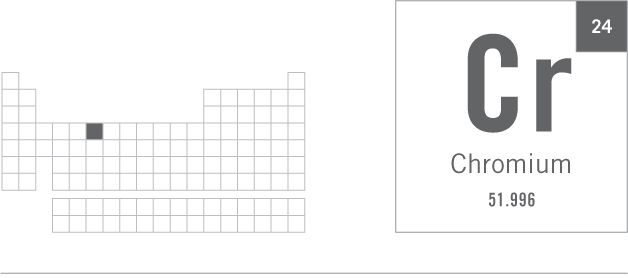For chromium, think colored salts, think chrome’s hard, rust-free shine,
Think rubies’, em’ralds’ sparkled bling, which Cr helps define.
There’s toxic “hexa,” vital “tri,”

For chromium, think colored salts, think chrome’s hard, rust-free shine,
Think rubies’, em’ralds’ sparkled bling, which Cr helps define.
There’s toxic “hexa,” vital “tri,”
GROUP 6 TRANSITION METAL
The name chromium comes from the Greek word chroma, which means color. Like many other transition metals, chromium forms an array of colored salts. Examples include green chromium(III) oxide (Cr2O3), yellow lead(II) chromate (PbCrO4), orange potassium dichromate (K2Cr2O7), and dark red chromium(VI) oxide (CrO3). These colors owe their existence to the d-electrons in these chromium ions that absorb specific wavelengths of visible light. The absence of these absorbed wavelengths from the spectrum of visible light makes the remaining light appear colored. (See “Niobium, Nb” on page 120 for information on wavelengths and visible light.)
The durable, corrosion-resistant, shiny chrome of kitchen appliances and classic car bumpers is due to a very thin layer of chromium metal electroplated onto a thicker layer of nickel. The nickel layer in turn is electroplated onto a base layer of iron, zinc, or brass (a copper-zinc alloy).
see-arr
Some emeralds get their green color from small amounts of vanadium present within their crystalline structure of beryllium aluminum silicate (Be3Al2(SiO3)6). Others rely on chromium to perform the same neat trick. And the chromium within the crystalline structure of aluminum oxide (Al2O3—or corundum) gives otherwise clear crystals a dazzling red color, transforming them into rubies!
Compounds containing chromium in its +6 oxidation state (hexavalent chromium) are often referred to as chromium(VI) compounds. The World Health Organization’s International Agency for Research on Cancer (IARC) has classified chromium(VI) compounds as carcinogenic (that is, cancer causing) to humans. But trace levels of chromium in its +3 oxidation state (trivalent chromium) play an essential role in our bodies’ utilization of glucose.
iron-enn-eye
Alloying up to 15 percent chromium with iron and nickel produces the stainless steel in everyday tableware cutlery.
vee
Open any toolbox and chances are at least one wrench proudly proclaims its hardened credentials via the “chrome-vanadium” or “Cr-V” marking stamped on its grip handle.
